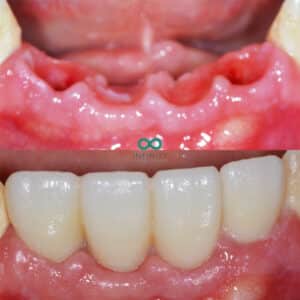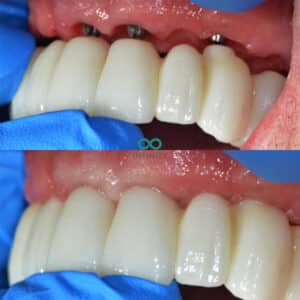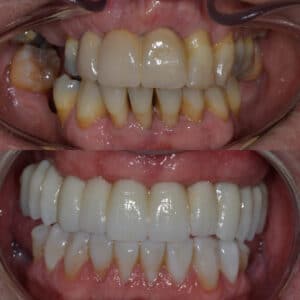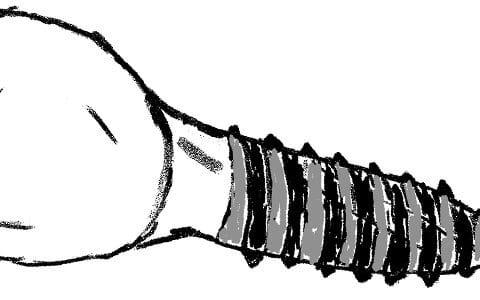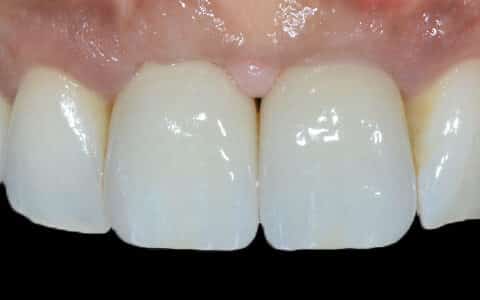Achieving natural aesthetics on anterior teeth is one of the most challenging tasks with regards to providing treatment with dental implants. The technicians can provide the most beautiful ceramic work however, if the gum shape does not match the adjacent teeth then the overall aesthetic appearance is significantly compromised.
The art of gum shaping is a critical part of implant treatment in the aesthetic zone (smile area) of the mouth. There are many ways to provide this treatment and I will briefly describe one of the techniques we use at our clinic.
WHY PROVIDE GUM SHAPING?
In most cases (not all, but most), the healing abutment around dental implants are a circular shape. Teeth in the anterior aesthetic zone have a more conical and varied anatomy. This anatomical shape determines the shape of the gingival margins and interdental papilla (pink gum triangles between the teeth). If a permanent implant crown is made using a single impression of the gums following removal of the healing abutment then the shape of the future tooth will be determined by the cylindrical shape of both the implant and the healing abutment. In many cases this is not going to enable the provision of an aesthetic tooth replacement to match the adjacent teeth.
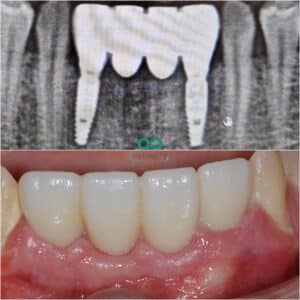
GUM SHAPING AROUND DENTAL IMPLANTS
The gum (soft tissues) around the implant needs to be carefully manipulated to provide a similar contour to that seen on the adjacent central incisor in this example. Rather than simply accepting a compromised result, we often provide our patients with a prototype implant restoration. This looks and feel almost as good as the final tooth which is great for patients as it means they are able to have a replacement tooth very early on in their overall treatment process.
The prototype can be altered to have composite added to it. The composite is carefully placed onto the relevant part of the apical third of the restoration. This will allow for the careful manipulation of the crown morphology that is in direct contact with the soft tissues. If a small amount of composite is added to the middle of the crown (see image below) this will create blanching of the soft tissues in this area. Over 7-10 days, this will result in the redistribution of the gum so that an apical zenith is created in the area where the composite was added and the gum will have been pushed into the interproximal spaces to reduce any black triangular spaces.
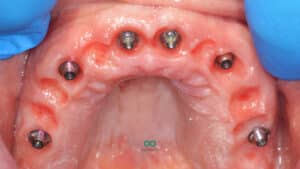
GUM SHAPING TO MAKE 2 DENTAL IMPLANTS LOOK LIKE 4 OR MORE INDIVIDUAL TEETH
The art of gum shaping can be used to manipulate the gums to such an extent that every tooth on an implant bridge is made to look like an individual tooth. The image below shows how we created 12 individual gum contours so that 6 implants can be used to support a full arch of 12 teeth that look individual with independant gum contours. These teeth will look more natural and aesthetic as well as being much easier to clean and maintain in the long term due to have a better gum seal around each tooth.
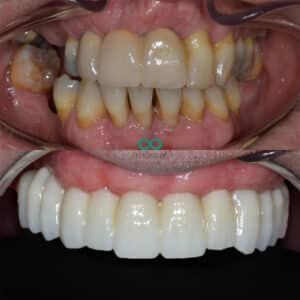
SUMMARY
Implant dentistry in the aesthetic zone must take soft tissue management into consideration. The aesthetic appearance of the final tooth is critical when determining the success of the treatment. For predictable and consistent outcomes, we believe it is imperative that implant surgeons provide gum contouring as part of their aesthetic implant treatment.
I hope this blog gives an easy to understand insight into this procedure. Please feel free to contact me for any queries or for information on further training in this field.
Thank you for reading
Mohsin Patel BDS MJDF RCS (Eng)
Related articles...
Book a Consultation
At Infinity Dental Clinic we see patients for routine dental check-ups with our dentists. Regular dental maintenance and good oral hygiene will ensure that you keep your teeth and gums healthy.
Book a Consultation







